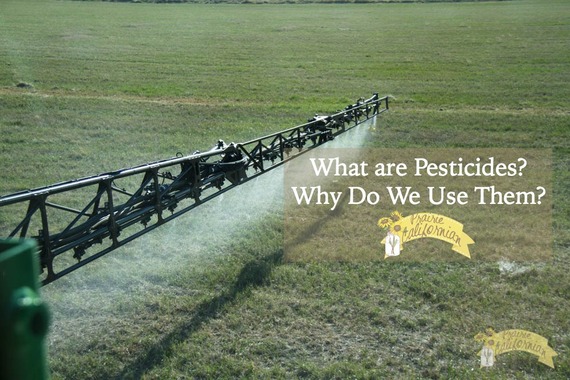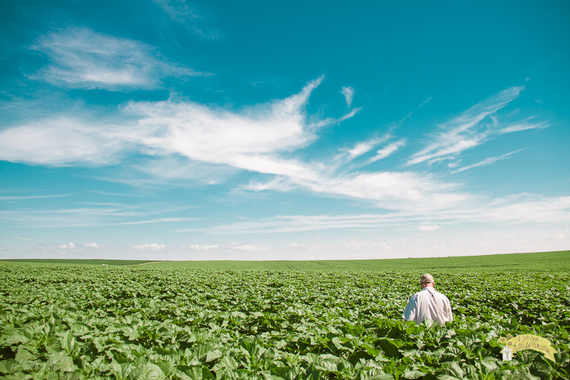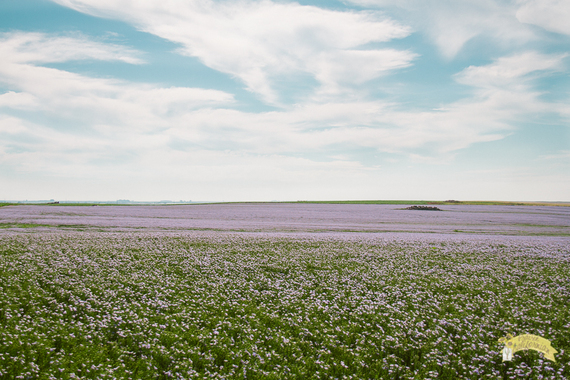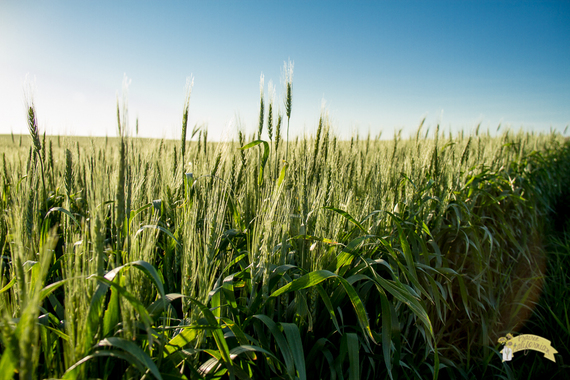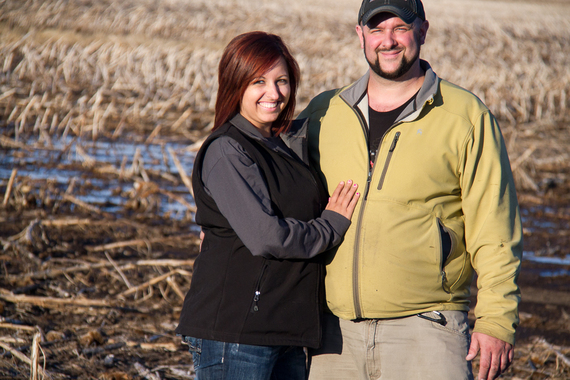When people talk about using chemicals on the farm, oftentimes they use the word "pesticides." To people outside agriculture, pesticides tends to be the catch-all category for any and all chemical compound we spray on our crops. And honestly, that is far from the truth. We don't have a jug labeled "pesticides" that goes on anything and everything. In agriculture we call any sort of chemical we use on the farm "crop-protection products."
The truth about the crop-protection products we use on the farm is that we use specific chemicals labeled for very specific uses and at very specific amounts. I've written before that as farmers we have a choice in what seed to select. We also have a choice when it comes to what we put on our crops. It varies depending on crop, soil, crop rotation, current condition of the crop, pests, and moisture. The choices we make regarding what to spray are careful, calculated, and measured out. It is not something we do haphazardly or thoughtlessly like many websites will suggest.
In the agriculture world we typically categorize crop-protection products under many different types. I want to share with you those different types, why we use them, and how they affect the crops on our farm. In order to understand how and why we use certain chemicals, it is important to understand the science behind how and why they work. Think of it like this: If you were looking to clean your floor, you wouldn't use the soap formulated to clean your dishes. You would use whatever is specific to that particular task.
I have done my best to break this down in the simplest terms I can.
(Disclaimer: I understand this is a hot-button topic, and I ask that if you choose to comment, please be respectful. This is our life and our livelihood, and it is not something we take lightly.)
Checking sunflowers growing in the field
Herbicides
Much as in your home or garden, controlling weeds is important to ensure that your crop grows. In the 1940s a new breed of herbicide was born that allowed for relatively low amount of chemical applied, using low volumes of water, meaning that we could selectively kill the weed without harming the crop plant.
Herbicides work in several different ways by affecting their target weeds: destroying cells and tissue; preventing cells from dividing, thus keeping the plant from growing; promoting uncontrolled growth, thus killing the plant; or disrupting vital enzyme systems within the plant.
We call these different methods "modes of action," and it is through these modes of action that herbicides are categorized. For example, glyphosate (Roundup) is a mode of action that inhibits an enzyme that is vital for plants to make particular amino acids. Without these amino acids the plant dies. Animals do not require this, which means glyphosate has relatively low toxicity to mammals, insects, and fish.
Herbicides are also categorized by what we call "modes of uptake." Not all herbicides reach the plant by the same method. Some herbicides act on the plant when they first touch it, some are absorbed from the soil by the roots, and some enter the plant by absorption through the leaves.
Flax blooming in the field
Insecticides
Insecticides are chemicals used to control insects by killing them or preventing them from engaging in behaviors that are destructive to crops, like eating them. Many insecticides act upon the nervous system of the insect by inhibiting or blocking enzymes.
As with herbicides, there are varying modes of entry for insecticides to work. Residual insecticides remain active in amounts sufficient to kill pests for a specific amount of time. These residual insecticides act by keeping a toxic residue on a surface that the insect will come in contact with.
Contact insecticides control the pest on contact and are applied directly to the insect, which is killed after it comes in contact with the insecticide. Very little toxic residue remains on a surface after spraying a contact insecticide. Think about when you fog for mosquitoes or flies.
Systemic insecticides enter the insect's host plant and translocate throughout the host plant. When an insect feeds on the host, it ingests enough insecticide to be lethal. And finally, stomach poisons are insecticides eaten by an insect so that the poison enters the stomach and is then absorbed into the body.
Insecticides are also classified by their chemical basis. These are big, scientific words, but here are several of the classifications: organophosphates, carbamates, miticides, pyrethoids, and neonicotinoids. If you are interested in reading more about these classifications, here is a great writeup.
Wheat shortly after flowering
Fungicides
Disease is a major source of crop and plant damage that can be caused by fungus. Fungicides are used to control fungal disease by specifically inhibiting or killing the fungus causing the disease. In contrast with human medicines, most fungicides need to be applied before the disease occurs, or at the first appearance of symptoms, to be effective. And also unlike in humans, the damage caused by diseases on plants often does not go away, even after the pathogen is killed. Fungicide can only protect new, uninfected growth from disease, so you can see why fungicides play an important role in crop protection.
As with insecticides and herbicides, there are different classifications of fungicides. Contact fungicides remain on the surface of plants, while systemic fungicides are absorbed into the plant. There are also different modes of action. Fungicides kill fungi by damaging their cell membranes, inactivating critical enzymes, or interfering with key processes such as energy production or respiration.
Conclusion and Discussion
Knowledge of exactly how an herbicide, insecticide, and fungicide affects its target is helpful and critical for selecting products. Products are not just selected at random but, as I said before, are carefully chosen, with many factors taken into consideration. Oftentimes farmers will consult a professional called an agronomist to make pesticide recommendations. Knowing the mode of action determines how the pesticide will affect the target. Sometimes different modes of action are needed in successful and effective crop protection. One of the reasons we rotate our crops is so that our soil isn't getting the same modes of action year after year.
I want to end this by reiterating that I know this is a hot-button topic. It isn't something that is easy to talk about. Pesticides are complex and involve science, and some pretty hardcore science at that. But having these conversations is important.
I understand that not everyone agrees with using pesticides on their farm, but I expect the conversations and dialogue here to be respectful and intellectual.
Please remember that we are all people, no matter what side of the fence we are on. Whether we are organic farmers, employees for the dreaded Monsanto, or conventional farmer, we have families, friends, and people we care about. We are all passionate about the food we eat and how it ends up on our tables. We all care about the healthy and safety of those we love, and farmers are no exception.
Look at this list; look at the choices we are offered as farmers. Let's celebrate that choice. Let's celebrate that farmers are given choices so that we can produce the very best crops we possibly can so that you, the consumer, can have choices when it comes to the food you find in the grocery store and beyond. And finally, let's all work together, have conversations, and do further research so that more people across the globe can be given those choices too.
Mark and Jenny Rohrich
To read more about our farming, visit prairiecalifornian.com.
Resources on pesticides:
